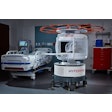
New data are raising questions about how long it takes gadolinium to exit the body after MRI scans. Using urine samples, researchers from gadolinium patient advocacy group the Lighthouse Project found elevated levels of gadolinium in patients years after their scans -- levels that exceeded the reference levels of some labs.
The report, published on the Lighthouse Project website, included 63 patients who underwent at least one MRI scan with a gadolinium-based contrast agent (GBCA). The patients reported gadolinium concentrations in their urine far above expected levels within the first month of the MRI scan, and there were lingering traces of the element more than a year later.
"The intent of this paper is simply to provide the evidence that, at least in our gadolinium toxicity support group, gadolinium from all agents remains in the body longer than most medical practitioners and governing authorities expect," wrote co-authors Hubbs Grimm and Sharon Williams, co-founders of the Lighthouse Project. "Based on what has been published about gadolinium's toxic effects, prolonged retention appears to be the likely cause of patients' new and unexplained symptoms following contrast MRIs."
The Lighthouse Project
The Lighthouse Project was co-founded in 2014 by Grimm and Williams to increase awareness among patients and physicians of how gadolinium retention could have lingering adverse health effects. The pair met in 2011, while they both were experiencing health problems they attributed to gadolinium-based contrast. They continue to deal with health issues today.
 Hubbs Grimm, co-founder of the Lighthouse Project.
Hubbs Grimm, co-founder of the Lighthouse Project.Over the past several years, Grimm has collected urine sample data from symptomatic patients in the Lighthouse Project's gadolinium toxicity support group. According to these patients, their renal function was normal at the time of their GBCA-enhanced MRI scans. They provided urine samples to test for any residual gadolinium at various time points after their scans.
The patients received one of four linear GBCAs -- gadopentetate dimeglumine (Magnevist, Bayer HealthCare), gadobenate dimeglumine (MultiHance, Bracco Imaging), gadodiamide (Omniscan, GE Healthcare), or gadoversetamide (Optimark, Guerbet) -- or one of three macrocyclic GBCAs -- gadoterate meglumine (Dotarem, Guerbet), gadobutrol (Gadavist, Bayer), or gadoteridol (ProHance, Bracco). In some cases, patients received more than one of the GBCAs.
"We did not control any of the ... urine testing done by the individuals and their doctors," Grimm and Williams wrote. "We have simply used their self-reported results retrospectively."
The authors used a maximum of three results from any one subject so no person's results could disproportionately affect the final numbers. In cases of multiple urine tests, they used the first result, the last result, and a reading from a middle time point, if applicable.
Retention rates
 Sharon Williams, co-founder of the Lighthouse Project.
Sharon Williams, co-founder of the Lighthouse Project.One analysis covered the first 30 days after GBCA administration, during which 35 urine samples were acquired. Gadolinium concentration ranged from a high of 507 mcg/24-hour specimen after six GBCA administrations to a low of 6.7 mcg in the fourth week after two GBCA-enhanced scans. In all, 26 (74%) cases recorded less than 100 mcg of gadolinium at least 10 days after one or more GBCA exposures.
Despite the decrease in gadolinium concentrations over that time, the results were well above accepted norms, which one lab specified as less than 0.7 mcg of gadolinium/24-hour specimen.
"None of the test results is even close" to that range, the authors noted.
Grimm and Williams also looked at 13 patients with a total of 18 urine tests performed more than 24 months after GBCA-enhanced MRI scans. As one might expect, gadolinium concentrations were markedly reduced, ranging from a high of 0.79 mcg after 45 months with nine GBCA administrations to a low of 0.08 mcg after 39 months from two GBCA MRI scans.
Still, there were a couple of cases in which gadolinium lingered for longer periods of time. One patient reported 0.61 mcg of gadolinium 86 months after nine administrations of a GBCA, and one person reported a urine sample of 0.1 mcg of gadolinium 124 months after one GBCA injection.
"With results out to as long as 10 years after the last contrast administration, this demonstrates that gadolinium is retained and being excreted much longer than expected," the authors wrote.
Grimm and Williams also analyzed results for each of the seven GBCAs to determine trend lines for gadolinium retention in the urine samples. As time passed, the values showed reduced gadolinium retention for each GBCA.
| Gadolinium retention at selected time points after GBCA administration | ||||||||
| Months | ||||||||
| 0.5 | 1 | 2 | 3 | 12 | 24 | 36 | 48 | |
| Linear GBCAs (mcg/24 hour) | ||||||||
| Magnevist | 45.14 | 13.50 | 4.04 | 1.99 | 0.18 | 0.05 | 0.03 | 0.02 |
| MultiHance | 22.55 | 7.99 | 2.83 | 1.54 | 0.19 | 0.07 | 0.04 | 0.02 |
| Omniscan | 20.40 | 8.71 | 3.72 | 2.26 | 0.41 | 0.18 | 0.11 | 0.08 |
| Optimark | 76.27 | 13.93 | 2.54 | 0.94 | 0.03 | 0.01 | 0.00 | 0.00 |
| Macrocyclic GBCAs (mcg/24 hour) | ||||||||
| Dotarem | 107.29 | 16.15 | 2.43 | 0.80 | 0.02 | 0.00 | 0.00 | 0.00 |
| Gadavist | 66.66 | 15.61 | 3.66 | 1.56 | 0.09 | 0.02 | 0.01 | 0.00 |
| ProHance | 108.77 | 14.29 | 1.88 | 0.57 | 0.01 | 0.00 | 0.00 | 0.00 |
Supporting research
So how should these results be interpreted? In several ways, this research confirms published studies showing that traces of gadolinium can remain in patients with normal renal function years after contrast administration, according to the authors.
"If it is a patient, one of the things we hope to do is to give people a better understanding of how to interpret their test results," Grimm told AuntMinnie.com. "From my point of view, the big issue is that the medical practitioners have become quite calm in saying to people: 'It will all be out of your system in two or three days.' This data, for these people, clearly indicates that is not the case."
Grimm and Williams say they do not plan to submit the paper for peer-review publication. The paper does, though, include recommendations: The authors strongly encourage regulatory agencies to have all GBCA manufacturers conduct prospective research to measure gadolinium in patients' urine daily for one month after contrast administration and then weekly for an extended period of time.
In addition, Williams hopes researchers, physicians, and the U.S. Food and Drug Administration (FDA) can use this study to better inform patients about the potential side effects of gadolinium-based contrast.
"There has been a failure to communicate clearly to clinicians and make them aware that patients, we now know, are retaining gadolinium," she said to AuntMinnie.com. "If these patients have unexplained symptoms after a recent MRI scan, gadolinium should be investigated as a potential cause. This really is a big issue that somehow we have to get a better handle on and gather data from medical professionals, not just from patients who have been affected. We've come a long way, but, unfortunately, I think we have a long way to go."


.fFmgij6Hin.png?auto=compress%2Cformat&fit=crop&h=100&q=70&w=100)





.fFmgij6Hin.png?auto=compress%2Cformat&fit=crop&h=167&q=70&w=250)











